The Legend Of BIGFOOT 4
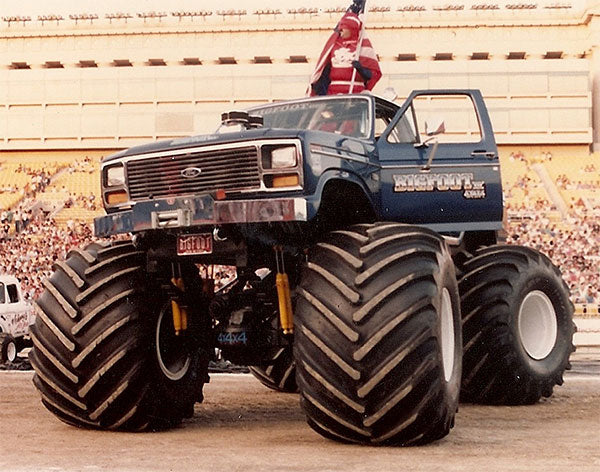
For a monster truck connoisseur, trying to tell the tale of BIGFOOT #4 is not exactly the easiest of tasks. While at first it looks to be a simple job for even the most novice of storytellers, further examination reveals that it is not quite a walk in the park. While a great bulk of the truck’s on-track history is easily accessible via home videos, YouTube and fan websites, the reality of the situation is that many details surrounding the truck’s construction, early life, and non-televised accomplishments have been a mystery for literally decades.
By the time BIGFOOT #4 arrived on the scene (not even a year after #3), the four-wheel drive press had already begun to grow accustomed to the trend of new BIGFOOT trucks being constructed, and for them it wasn’t something fit for a cover story anymore (at least not until years later). To the layman, #4 looked too similar to #3 to merit such fawning attention, especially considering the fact that #3 had so recently dominated the cover of at least three magazines. Consequently, the magazines all but omitted the ground-breaking technical changes that had been incorporated into the new truck, and subsequently missed out on the “See, we told you so!” factor when the truck proved itself an amazingly potent performer. This history of the truck is the culmination of quite literally months of research, archive recovery, and interviews in hopes of establishing the most detailed, accurate portrait to date of this legendary machine.
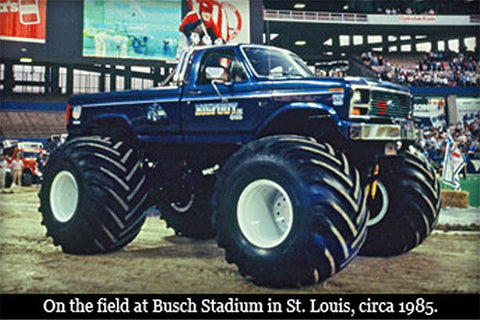
For an individual truck, the list of adjectives that can be used to describe BIGFOOT #4 are almost innumerable. BIGFOOT #4 was ground-breaking, innovative, savvy, aggressive, highly effective, seemingly indefatigable, immensely popular, overpoweringly cool, and wildly over-the-top on-track. BIGFOOT #1 might be the grand-daddy of ‘em all, but in many ways BIGFOOT #4 by all rights truly earned the title “King of the Monster Trucks”.
Few (if any) other monster trucks can claim to have a cult of personality such as that attributed to BIGFOOT #4. BIGFOOT #1 is certainly the most famous of the ‘Feet, but BIGFOOT #4 took the team’s torch and ran with it into areas previously uncharted, and in many cases simply never before dreamt of. With a career spanning over two decades and a history of legendary toughness that has given the truck an almost mythical status among hard-core fans, BIGFOOT #4 is in many ways just as important to the BIGFOOT story as any other truck in the fleet.
Doing More with Four
The creation of BIGFOOT #4 was spurred on not only by the ever-increasing demand for BIGFOOT trucks to appear all over North America, but also by the team’s desire to built the toughest, most-capable truck yet. Hill-climbing prowess and mud bog-blasting capability were less important to Chandler and Co. during the design and construction of #4; rather, the ability to withstand the increasingly more brutal world of car crushing exhibitions and sled pulls was put at the top of the list for the new machine.
It was obvious that a new approach would be required to make this vision a reality. The first three BIGFOOT trucks were remarkably strong relatively speaking, but it had become painfully clear that this first generation of monster truck wasn’t going to be strong enough to keep up with the rapidly evolving forms of competitions that promoters were devising, and with the competition itself. By this point many monster builders were no slouches; quite the opposite in fact. Trucks like Taurus, Bearfoot, Excaliber, Virginia Giant, and Awesome Kong were upping the ante at every turn of the tire, forcing the BIGFOOT team to reexamine just exactly what was needed to make a monster truck truly competitive. But by the time BIGFOOT #4 debuted, the truck was not only competitive, but it was virtually dominant.
Although BIGFOOT #4 was drastically different from its three elder brethren in many ways, perhaps the most important of those differences was the approach the team took to creating the frame for the new beast. While the first three BIGFOOT trucks utilized stock F-250 pickup truck frames as the basis for their construction, #4 would instead utilize a heavy duty straight-rail frame sourced from a heavy industrial/vocational truck. Using a heavy frame design not only saved the team time by eliminating the need to modify and reinforce a relatively weak light truck frame, but it allowed them to mount various chassis components, cross members and other accessories wherever they pleased, as opposed to being at the mercy of factory frame restrictions.
 |
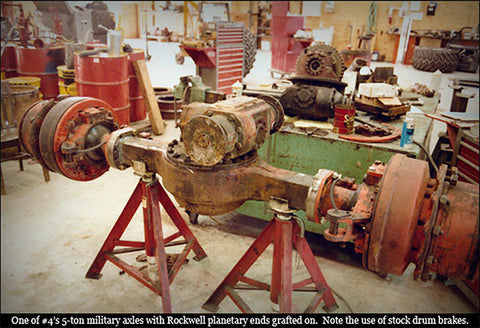 |
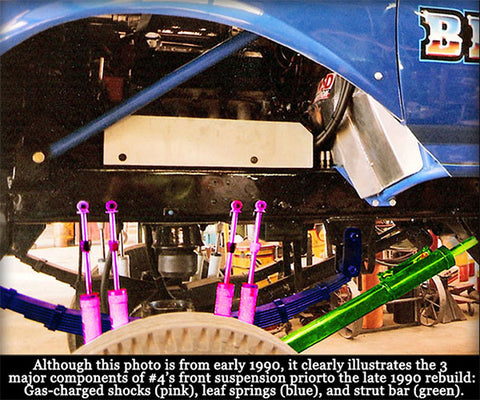 |
Some changes were definitely in order for BIGFOOT #4’s running gear as well, changes that would help lead to its drastically improved level of performance over prior BIGFOOT trucks, and over that of its competition as well. While the truck would continue the tradition of using the tried and true 5-ton Rockwell military axle as its foundation, the factory steering knuckles and non-planetary outers would end up getting torched off and tossed in the scrap bin, in exchange for something right out of the Gold’s Gym Truck Parts catalog: Rockwell planetary ends. These Rockwell planetary outers and the heavier-duty steering knuckles that went with them would not only take a great deal of strain off the truck’s internal axle components (namely axle shafts), but it would also allow the truck to absorb a great deal more punishment without fear of breaking knuckles or spindles. Stopping power was provided by enormous (and enormously heavy) Rockwell drum brakes mounted at each hub, which would eventually be replaced by disc-type pinion brakes towards the end of the 1980’s.
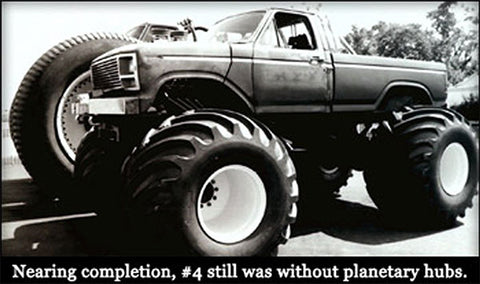
Moving on up the drive train ladder, #4 would begin its life using the same 2 ½-ton International Harvester 2-speed transfer case and built-up C6 transmission found in previous BIGFOOT models, along with virtually the same 460ci Ford V8 bored .030 over, supercharged on race gas fed by dual Predator carburetors. With a solid 800hp, a near-bulletproof drive train, and an axle combination strong enough to make a heavy crane operator jealous, #4 was shaping up to be a beast mean enough to scare Godzilla and Tokyo at the same time.
Boing, Boing, Boing
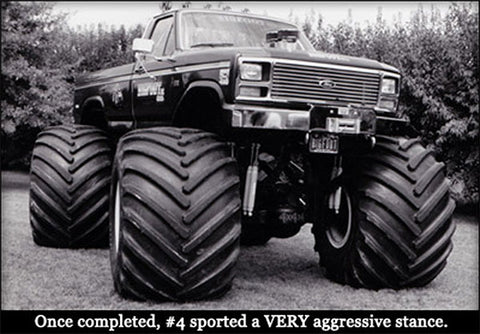
A plush ride and indelible road manners were not to be found in the first three BIGFOOT trucks and….well….such would not be the case with #4 either. Relatively speaking, however, the truck enjoyed one of the better working suspensions when compared to many of its contemporaries, especially at the time of its debut in 1985 (later suspension modifications will be addressed later.)
Initially #4 was equipped with heavy-duty, custom-arched leaf spring packs at each corner. Verbiage in the press at the time of the build refers to the springs as “researched leaf spring packs”, which one can only assume means the team did enough looking around at other monster trucks (and at their own existing ones) to realize that highly-arched, U-shaped leaf spring packs yielded vary little in the way of suspension travel. To help dampen these mighty packs of leafs, #4 relied upon four gas charged shock absorbers per corner, for a grand total of 16. That may sound like an excessive number of shocks considering today’s monster trucks employ half that number or less, but at the time #4’s suspension design was, at least visually, quite minimalistic compared to some of the competition’s rides, which featured in some cases eight or more shocks per corner.
BIGFOOT #4, like its predecessors, relied upon a non-articulated link bar mounted on the bottom of each frame rail running down to the rear axle to help with stability. This link bar allowed the rear leaf springs to move through their natural arc while still serving to keep the axle firmly located with regards to fore/aft and side-to-side movement. Also, like prior trucks in the family, #4 debuted with hydraulic “strut bars” connecting the front axle to the frame for additional support. Consisting of nothing more than a rectangular tubing link bark with a constant-bypass hydraulic cylinder spliced into the middle, the strut bar allowed the front leafs to move through their natural arc, while still providing enough resistance to maintain proper axle location.
Tire and wheel selection for #4, at least initially, consisted of a standard set of full-cleat 66” tires mounted on white steel split-rims, with the split ring mounted to the inside for safety’s sake, although as time progressed the truck would be one of the first BIGFOOT machines to use one-piece wheels and hand-cut tires in the name of saving weight.
Available In Any Color, As Long As It's Blue
As one would expect, BIGFOOT #4 made its debut wearing a traditional all-blue paint job, complete with Dan Patterson’s requisite hand-painted logo and cartoon truck artwork. Like #3, #4’s sheet metal bodywork was that of a ’80-86 F-250, although #4 would show its hard-working “blue collar” roots right off the bat by eschewing any of the chrome bells and whistles that #3 is often remembered for.
As legendary BIGFOOT driver (and the first driver of #4) Jim Kramer put it: “Let’s be honest, #3 was a show truck. It was a show boat. A sponsor truck. We knew Ford wanted to use the truck in a lot of advertising, so we hung a bunch of chrome on it and detailed it so it looked really nice. That wasn’t #4. We built #4 to be tougher and to do more, so we skipped the chrome stuff. At that point we were tired of knocking the fiberglass fender flares off of #1 and #2 crushing cars, and we’d gotten into the body some on #3 so on #4 we opened up the fender wells more.”
The limited chrome found on BIGFOOT #4 in its early years came in the form of chromed front and rear bumpers and a double-hoop light bar, topped with the requisite five KC lights. Although this look would last less than two years before the 1987 body change, which saw the truck being re-bodied, it remains one of the most iconic looks in the history of the team.
King of the Monster Trucks
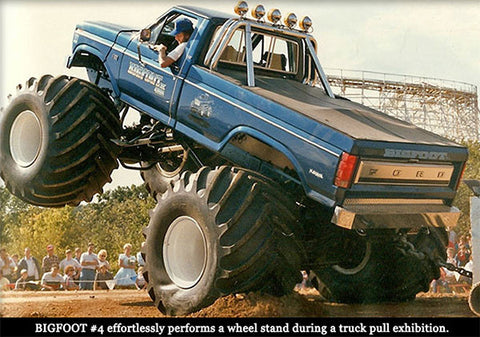
While construction on BIGFOOT #4 began at Midwest Four Wheel Drive’s original Lindbergh Blvd location in Hazelwood, MO in 1984, final construction and assembly was completed at their all-new purpose-built location down the road (at the intersection of Lindbergh and I-270) later that year. This made #4 the first new BIGFOOT truck to have rolled out the doors at the new facility (which the team still occupies). On July 31st, 1984, BIGFOOT #4 saw light in the public eye for the first time during the team’s grand opening for their new facility. Although the truck was not fully completed, the public (and the monster truck industry) had caught a glimpse of what was to come.
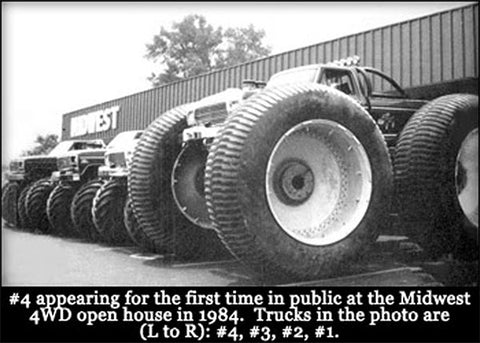
According to archived schedules from 1984, #4 made its on-track debut on September 14th, 1984 at the Riverside Centroplex in Baton Rouge, LA, crushing cars at an ATPA tractor pulling event. Shortly thereafter the truck appeared at the Marion County Fairgrounds in Indianapolis wearing the 10’ tall Firestone tundra tires that it would later become so famous for using to crush other monster trucks. Contrary to popular understanding, BIGFOOT #4 actually made its competitive car-crushing debut at the Barton Coliseum in Little Rock, AR in October of that year, followed by events in Niagara Falls, Montreal, Philadelphia, Indianapolis, and Cincinnati.
1985 would be an unbelievably busy year for BIGFOOT #4 and driver Jim Kramer, as the two became perhaps one of the (if not THE) most dominant truck/driver combinations the sport has ever or will ever see. At the time, essentially all monster truck competitions were either timed events on small obstacle courses or were "judged" competitive car crushing exhibitions between a handful of trucks. Although this may not sound like a breeding ground for fierce competition and rivalries, truth be told it was exactly that. The arenas, fairgrounds, and stadiums of the country served as a veritable Petri dish for the ever-growing monster truck industry and the various personality conflicts, rivalries, and innovations within it.
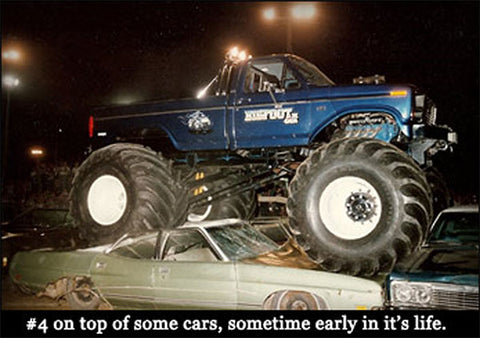
At every turn it seemed like Kramer and #4 were pushing back boundaries and constantly redefining what exactly a monster truck could, should, and would do in a competitive exhibition environment. Whereas previous BIGFOOT trucks hardly squeezed out more than a wheel-stand to get on top of the cars, Kramer was getting increasingly brave with #4, hitting the cars harder than anyone else and actually sending the truck into the air.
But all of this seemed almost trivial when, at the New Orleans Superdome in January of 1986, Kramer battled it out with seven other top monster trucks in what was billed as the first-ever true side-by-side monster truck race over an obstacle course. This event stands as one of the most important watershed events in the history of the monster truck industry, and at the heart of it all was BIGFOOT #4 and Kramer, who by the end of the night had virtually changed the course of the industry singlehandedly.
The race course at this event asked practically everything of these monster trucks: sled pulling, turning, hill climbing, car crushing, and mud running. Kramer and #4 handily defeated an early Stage 1 monster named “Frankenstein” in the first round of eliminations, followed by a swift victory in round two over the first Corvette monster, “Monster Vette”. Those two wins landed Kramer in the finals, in what would easily be the race of the night, a knock-down drag-out finale between Kramer, the consummate professional in what had so far been the most dominant truck in the building, against Jeff Dane in “Awesome Kong”, a capable underdog relying upon power from 3,000HP aircraft engine.
As the lights went green, both drivers quite literally floored it, conning every last bit of power out of their machines in an effort to claim perhaps the most important racing victory the monster truck industry has ever known. Kong’s impressive power was hardly subdued by both the weight of the sled and its nearly 8,000lb weight disadvantage compared to #4. Kramer managed to keep things fairly even to the end of the pull track, thanks in part to his combination of good reaction time on the starting lights and #4’s respectable power-to-weight ratio. As their ground crew frantically scrambled to unhook the rearing beasts, the advantage remained with Awesome Kong as Dane and Co. managed to get away from the sled a moment sooner than Kramer and #4. But the race was far from over.
BIGFOOT #4 roared to life only a moment later than Awesome Kong, and by the time the two trucks had entered the crisscross left hand turn, Kramer had made up substantial ground and forced #4 through a sweeping turn, no doubt the fastest outside turn of the night. From there the two goliaths charged up man-made dirt hills several feet high, with Kong still maintaining a slight advantage. But this is where guts, skill, and confidence in his equipment allowed Kramer to push #4 to a new level and take over the lead. As Kong lumbered atop the dirt hill, Kramer throttled #4 into the hill with a ferocity unmatched by any other drivers that night, or arguably at any time in history before. By the time both trucks had thundered back down to the ground, Kramer had closed the gap and as the two trucks approached the large set of crush cars, the difference between these two trucks and drivers became readily apparent.
Whereas Dane chose to ease off the throttle some and make a more deliberate run up onto the cars, Kramer stayed in the throttle and sent BIGFOOT #4 right through the first car and into the air. By today’s standards, this was hardly air, but for the time it was a daring and incredible step forward. The final obstacle was a 35ft-long mud pit with two crush cars placed at the exit, a slippery way to end an already tricky race course. By the time Dane and Kong were making their way off the crush car set, Kramer had plunged #4 into the muck and, in what seemed like only the blink of the eye, had cleared the final two cars and slammed back onto solid ground. Dane leaned hard on the loud pedal in these final few seconds of the race, desperately trying to put together a come-from-behind victory, but such would not be the case. Kramer and BIGFOOT #4 would not be denied. The King of the Monster Trucks had arrived.
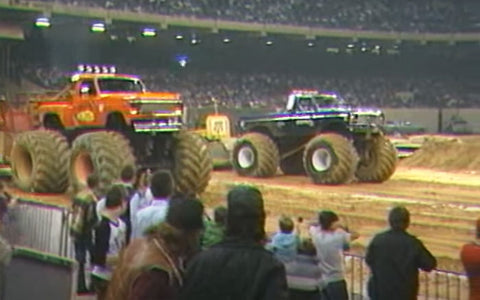 |
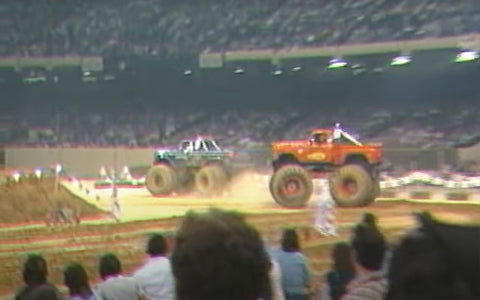 |
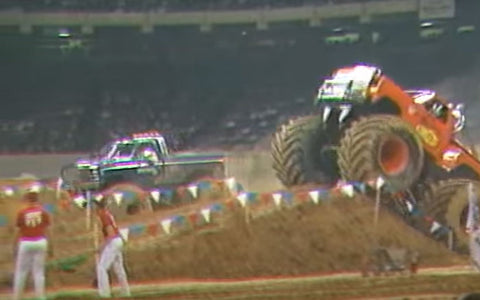 |
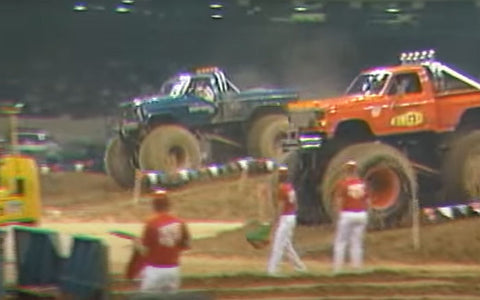 |
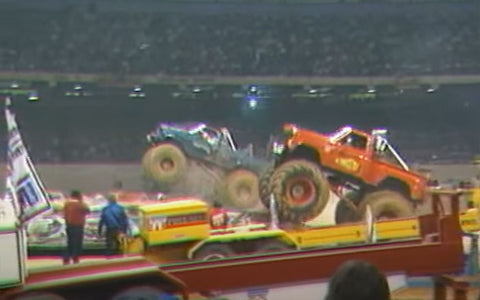 |
 |
After winning the first-ever monster truck racing event, Kramer and BIGFOOT #4 continued their reign of terror over the competition throughout the duration of 1986. Kramer, along with BIGFOOT creator Bob Chandler and many other industry experts, have maintained that the Superdome race event to this day remains one of the most important events in monster truck history, as it helped prove to the public, the promoters, and the teams themselves that these trucks had far more potential than was currently being realized.
Kramer has even gone on record to state that he feels that driving BIGFOOT #4 at the event was one of the defining moments of his career: “The [Superdome] show where we raced for the first time was a pretty big deal, not just for BIGFOOT as a team, but for everyone involved, and really the industry as a whole. I firmly believe we couldn’t have won that event with any of the other trucks we had at the time. #4 was the horse to have in that race, and it did its job. I think back on some of the neater things I’ve done in my career….driving #6 through the peristyles at the LA Coliseum, driving #7 through the dealership in Roadhouse, testing #8…and I still find myself feeling pretty fond of that event, and what it did for both BIGFOOT and the sport. It was a pivotal event.”
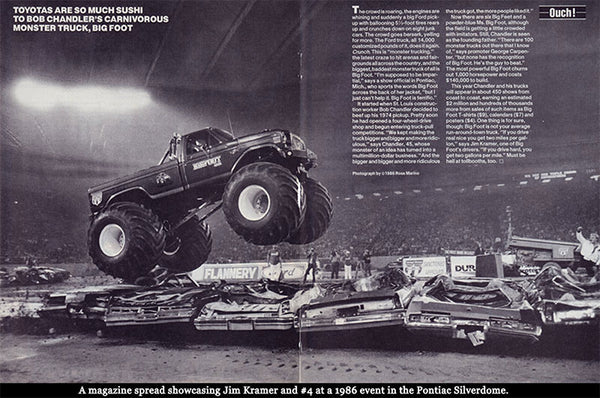
"Boeing Never Built Anything Like That"
The ’86 Superdome show, which was aired as a TV special and later released on home video as Return of the Monster Trucks, was far from the last hurrah for Kramer and BIGFOOT #4. As 1986 carried on, Kramer continued to push the truck harder and harder, especially when the level of intensity in the crowd justified such action. One of #4’s more memorable early flights occurred in October of ’86 at Oakland Stadium in Oakland, CA. In the final round of competition, Kramer (despite having a respectable lead) decided to tack on a few extra frequent flier miles before leaving the stadium. In his own words:
“We had a great crowd that night, if you look at the video or the pictures from the [Summer 1987 Truck Pulls] magazine, you’ll see the place was pretty packed. We’d done pretty well all night, and when I came around the last turn, I pretty much just nailed it for all it was worth to see if I could clear the cars. The landing was really rough…had I not cleared the last car with the front tires, it probably wouldn’t have hurt as bad. As it was, it tweaked my back pretty good and I ended up having to fly home the next day, lying on the floor of the airplane for most of the ride, and someone else had to bring the truck home. I took a week or so off afterwards [laughs], but that’s just what we did back then. We tried to please the people.”
The magazine spread that Kramer refers to above featured a sequence of photographs that illustrate Kramer’s epic flight, titled with the phrase “Boeing Never Built Anything Like This.” Little did the press, and the monster truck fan base, realize what great heights BIGFOOT #4 was still to reach.
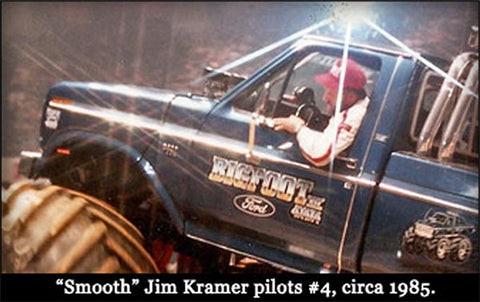
Remarkably, BIGFOOT #4 sustained no notable mechanical damage after that run, no doubt reinforcing the belief that most Stage 2 monster trucks had become more resilient than their drivers. But it should be noted that the quality of construction found in trucks like #4 did a great deal to add to the growing monster truck fan base, and to keep existing fans interested. Trucks like BIGFOOT #4, when in capable hands, were able to put on a much more entertaining, consistent show than the generation of trucks that came before them. One magazine writer, having just witnessed his first monster truck event that a Stage 2 BIGFOOT truck was competing at, remarked that he “couldn’t believe the level of abuse the trucks and drivers sustained without attrition.”
With actions like this becoming more and more frequent, BIGFOOT #4 and Kramer had quickly turned into the scourge of the monster truck circuit. And not only that, but he had become the de-facto “wild man” driver on the team, performing tricks like the “tire walk” and becoming the first BIGFOOT driver to roll a truck over in Murray, KY in 1986. Reflecting on that event, both Kramer and Bob Chandler are quick to note that despite the rollover during the first night of the weekend, #4 (with a little TLC) was able to complete all of its car-crushing and sled-pulling duties for the weekend, on time and in (relatively) good shape. Kramer’s take on #4’s dominance and durability makes clear his admiration for the truck:
“BIGFOOT #4 was the first truck I drove that, when I got in it and drove it, I thought to myself, 'Hey now, we can really do some stuff with this thing.’ When I rolled the truck in Murray, KY, all we did was knock the rest of the glass out of the truck, vacuum it out, check the oil and the plugs and we were back out there on time pulling the sled and crushing cars. The thing was just plain tough, and I’m not saying there weren't other tough truck out there at the time, but I really think #4 was the truck that dragged monster trucks kicking and screaming into the next level of performance.”
 |
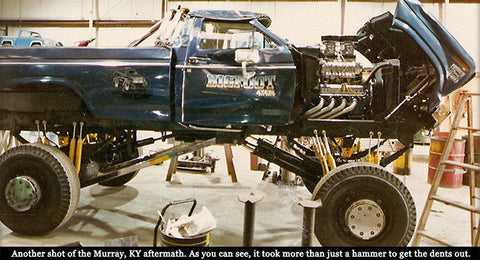 |
Kramer also recounts an interesting story from a 1986 event at Texas Stadium in Dallas, when it was pointed out to him that he and #4 weren’t exactly popular with the competition: “After we parked [the hauler] outside the stadium, we went in to say hello to everybody; back then pullers and the monster truck guys and everyone were pretty good friends, so we were talking to one of the pullers and he said ‘You know them boys don’t like it when you pull in with that truck.’ Apparently one of the drivers didn’t know it was myself and #4 coming, and they remarked ‘Well there goes the weekend, ain’t any of us winning anything.’ I didn’t care. I ran everybody as hard as I felt was necessary because that’s how we did things back then. If nobody wanted to go first on the track and hit fresh cars, I’d always volunteer. #4 was heavy enough and had a good enough motor that when I’d wail on that first car, I’d just make my own ramp and be on my way. The competition was always quick to play catch up, but for a while there that truck could hardly be touched."
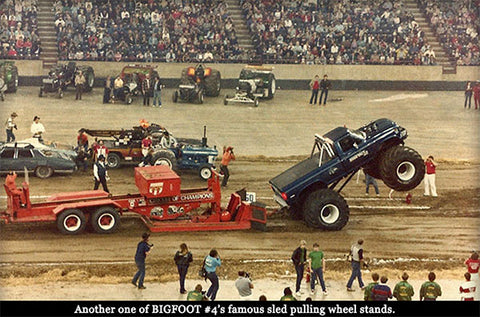
With #4’s body completely totaled in the Murray, KY roll-over, the team had to scramble to get the truck ready for its next event, a mere week away in New Orleans, LA. With the truck scheduled to receive updated styling to match the newest F-250 trucks on the market, the team chose to outfit the truck with the newer bed and cab but retained the older ’80-’86 nose for Kramer’s final event in #4 at the New Orleans Superdome, as the team was not scheduled to debut the new look for the fleet until January. Although this cosmetic mis-match went largely unnoticed by fans, a sharp eye for detail will note that at the Superdome event, #4’s bed sides feature the modern-looking “tear drop” shaped wheel cut-out treatment, while the front wheel cut-outs still match the older body style. Kramer would end up winning the event in fine fashion, capping off his run as BIGFOOT #4’s first full-time driver.
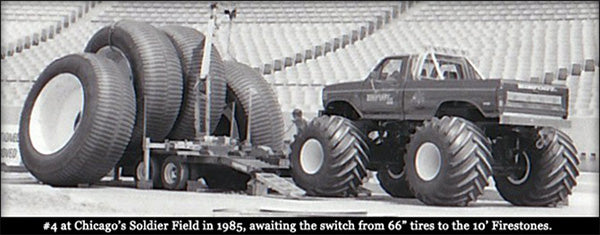
New Looks All The Way Around
For 1987, Kramer would move on to the all-new BIGFOOT #6 machine, while up-and-coming talent Rich Hooser would move into the vacant spot behind the wheel of #4. Hooser had been a crew member for a number of years at BIGFOOT prior to taking the reins of BIGFOOT #3 in 1985. Hooser continued the tradition of aggressiveness that Kramer had established in #4, and kept the truck constantly in the hunt for victory lane.
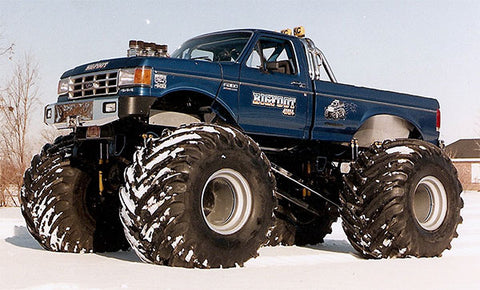
Hooser is, to this day, ecstatic about being moved up into the seat of BIGFOOT #4: “BIGFOOT #3 was my first baby, it was a great truck! Even though #3 looked awesome with the new body style and aluminum wheels (of which I cannot remember how many I bent up!) it just could not take the abuse I put it through and I guess Bob and Jim thought that #4 would be a good fit for me. [We were] getting into serious racing at that time, and I was very competitive and aggressive.”
BIGFOOT #4 kicked off the 1987 season with a fully-updated 1987 model F-250/350 sheet metal body in Charleston, WV with Hooser behind the wheel. Thus, began yet another successful driver-truck relationship, one that would last well into latter half of 1988. Hooser had little time to get used to his new ride, as major events in Tampa, San Diego, Hartford, Oklahoma City, and St. Louis cropped up almost immediately on the schedule for #4.
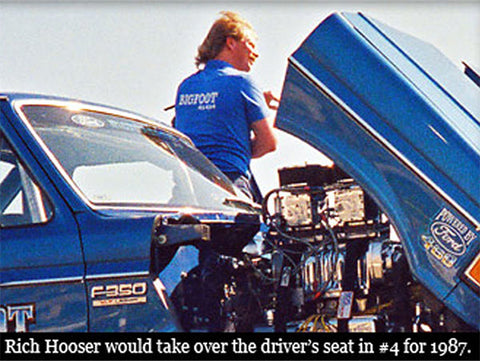
Few radical changes were made to BIGFOOT #4 during Hooser’s time behind the wheel, although one could argue that few were necessary as the truck was exceptionally competitive against even the newest trucks on the circuit. Hooser recalls that one of the biggest changes to #4 at that time was simply a better transmission: “I remember transmissions being a weak link at one time, so after shipping a new one to me a few too many times we started keeping a spare with us. But that was really not the answer, so a better transmission was built. After that, we started looking at the suspension, because at that time the only way to control the truck was with pure body strength.”
BIGFOOT #4 is often recognized as one of the better handling trucks of that era, but this is not to say that the truck offered its occupants a plush ride that was easy on the neck and back; quite the opposite, in fact. Although the team was learning to better tune the leaf spring packs used in #4 and its closest relative, BIGFOOT #6, it was very much a trial-and-error procedure. That, combined with the extremely busy schedule that the trucks adhered to, made this process of evolution very slow initially.
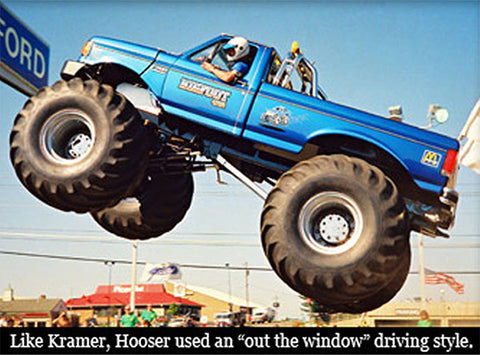
Much like Kramer before him, Hooser was often impressed with the amount of abuse the truck could absorb, and dish out: “#4 always surprised me with what it was capable of. Many a time I thought to myself ‘Wow, did I just do that and this truck is still running and in one piece?!’ A lot of times I also thought to myself ‘Wow, did I just do that and am I still in one piece?!” I think a lot of the abuse I took back then has a lot to do with the level of safety and comfort that drivers enjoy today.”
One particularly notorious example of the abuse Hooser and his contemporaries underwent behind the wheel of Stage 2 monster trucks at that time is clearly visible in an often-used video clip that depicts Hooser in the cab of #4 during a particularly brutal jump at an outdoor event. Hooser is seen approaching the cars at a fairly brisk pace, then is catapulted skyward as the truck wails on the set of cars. Upon landing, Hooser’s head and neck nearly disappear below and to the side of the steering wheel, despite his use of a neck collar and multi-point seatbelt system. One can only imagine the rough ride endured by other drivers who did not have the benefit of a [relatively] good working suspension such as that found beneath #4.
BIGFOOT #4 and Hooser dove headfirst into the 1988 TNT Monster Truck Challenge racing series, the first of its kind in the monster truck industry. Every team, truck, and driver stepped up their game immensely to try to win the first-ever monster truck racing championship. Kicking off indoors in St. Paul, MN, it became quite clear from the start that BIGFOOT #4, and an all-new version of long-time rival competitor USA-1, would be the top contenders for the series title.
Asked about competing in the first ever racing series points battle, Hooser has some interesting thoughts: “During the ‘88 points battle, I seem to recall there was a little controversy over the point standings at the end. Both Bob [Chandler] and I thought that though despite me losing the last race to USA-1, I still had more points, but really, I was always more focused on the race at hand than on the points. Overall, that year was probably the finest memory I have, of teams coming together to help each other with repairs and the friendships that were built along the way.”
The points controversy Hooser refers to has to do with TNT’s policy of adding up all of a truck’s points at the end of the season, and then counting only the best 29 (of a 39-race schedule). So, whereas BIGFOOT #4 actually finished the whole schedule more than five points ahead of USA-1, the best-of-29 counting method dropped #4’s points total to 278, as opposed to USA-1’s 292.5.
By season’s end, Hooser and #4 had competed fiercely and done well on a number of exceptionally difficult tracks like the Louisville Figure-8, Nashville Speedway, Lima Fairgrounds, and on the dreaded New York State Mini-Circuit of Middletown, Weedsport, and West Lebanon. Hooser bid farewell to fans at the end of the ’88 points chase in October at Freedom Hall in Louisville, KY, for the season finals, where USA-1 would wrap up its conquest of the 1988 TNT Monster Truck Challenge series, with Hooser and #4 coming in at a close second.
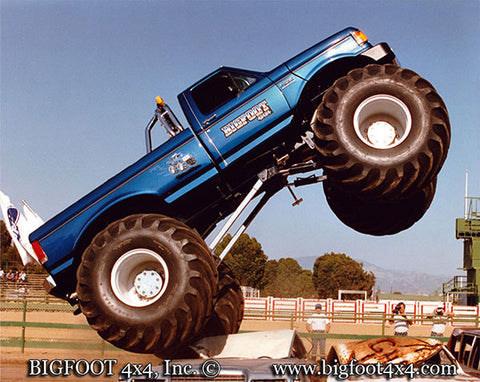
With a handful of non-points events left on the docket for 1988, Team BIGFOOT would rely on veteran crew member, shop mechanic, and driver Ken Koelling to fill in until the “starting lineup” for 1989 was determined. Koelling let no grass grow beneath the truck, as he proved himself a worth competitor behind the wheel of #4 in his TV debut at the Houston Astrodome, easily winning the USHRA’s season finale event against a field of very capable trucks. By the start of 1989, however, Koelling had moved on to BIGFOOT #6, which left the seat of #4 open for the next BIGFOOT driving prodigy.
Andy Brass began his career at BIGFOOT as a crew member, and soon thereafter made a name for himself as a quality man behind a welding helmet as well. Starting in 1985, Brass could often be found crewing for Jim Kramer, behind the wheel of BIGFOOT #4 and eventually BIGFOOT #6. As time went by, Kramer began trying to coax Brass to take a shot at driving, and eventually Brass took a stab at it and, as they say, the rest was history.

Brass’ full-time driving career began at the helm of BIGFOOT #3, where he distinguished himself as an aggressive and competent driver, later moving on to BIGFOOT #6 for a time. But it was not until he took the reins of BIGFOOT #4 in January of 1989 that he truly began to etch his name in the monster truck history books.
Shortly after Brass began driving BIGFOOT #4, the truck started to undergo a series of changes that would help make it lighter, faster, and better-handling in an effort to keep up with the increasingly clever and advanced trucks being fielded by the competition. Although #4 had been using a triple Predator carburetor set-up as early as the first quarter of 1988 in an effort to increase airflow heading into the truck’s 460ci motor, the setup had proven to be, if not reliable, then simply not powerful enough for the demands of all-out racing. Relying on the experience gained by using a bigger 540ci mill in BIGFOOT #6 during the ’88 season, the team procured another 540ci engine and installed it in #4.
The list of changes to BIGFOOT #4 in 1989 do not stop there, however; Fiberglass body panels began to see use, to the point that by the end of 1989 the truck’s top-half had been completely re-worked to include a full fiberglass body, all of which dramatically decreased the truck’s overall weight. Another major step forward in not only reducing the truck’s weight but also its stopping power was the removal of the factory drum brakes at each wheel, replacing them instead with a disc-brake system on the PTO flange at the top of each ring and pinion carrier. Although a great deal of monster trucks had been using “pinion brakes” for a number of years by the time #4 was switched over, the BIGFOOT team had been hesitant to deviate from the concept of having wheel-mounted brakes, which offered performance and safety benefits of their own. Interestingly, the team would revisit and come to rely upon wheel brakes once again during their switch-over to ZF axles in late 1991.

In 1989, BIGFOOT #4 also became the first member of the BIGFOOT family to campaign a set of “cut” tires (tires which had some of their tread cut off intentionally to save weight), which only further served to increase its performance. All of this translated to a leaner, meaner, faster version of BIGFOOT #4, a truck that now seemed light years ahead of the 1985 version of itself.
Brass and BIGFOOT #4 conquered a number of high-profile events in 1989, although the duo did not compete on the entire TNT points chase, appearing at fewer than 14 events on the tour, which placed them outside the top-5 in points at year’s end. This semi-hiatus from the series not only allowed Brass to mature as a racer, but also allowed the team to shift a great deal of their focus to developing and testing the revolutionary BIGFOOT #8, which they would unleash on the sport in late 1989, at which point Brass would become the full-time driver of #8 and yet another young talent would take the reins of #4.
License to Fly
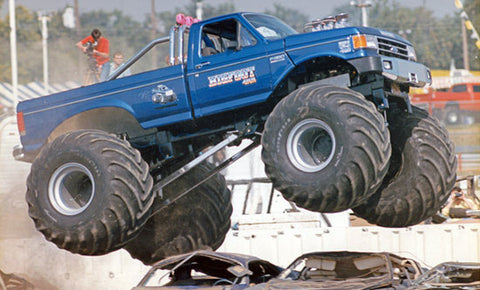
John Piant’s first event behind the wheel of BIGFOOT #4 as its new driver was the BIGFOOT Family Reunion at the ’89 Fall Jamboree in Indianapolis, IN, an event which celebrated Team BIGFOOT’s 5,000th appearance. Piant, a former BMX stand-out prior to joining the BIGFOOT team, had served as a crew member for Jim Kramer and Andy Brass before seeing seat time of his own in various BIGFOOT trucks, including numbers 3, 6, and 7. Piant recalls the lead-up to his maiden voyage in #4:
“I started off back then doing little fairs or car dealership crushes; that’s how BIGFOOT did stuff back then, starting you off slow like that. Basically, I crewed for a few different guys, and put some time in driving #2 and #3. The first time I got into #4 was at the ‘89 Indy Jamboree with all of the trucks there, running the obstacle courses and such. I don’t remember if it was musical chairs or if we had a driver shortage or what, but somehow, I ended up with #4 that weekend and really that was my first time on a race track with real jumps and stuff instead of just a car crush. Basically, I just jumped in and had at it, and ended up finishing second behind Andy Brass in #8. I think that opened Bob [Chandler’s] eyes up a little bit, and with my BMX experience the ramps and stuff didn’t really bother me. BMX gave me a great understanding of what the truck needed when it came to getting air.”

Although Indianapolis was not an easy event by a far cry, the all-BIGFOOT field of trucks left Piant with a good deal yet to prove. Piant’s first real-world test during his tenure as #4’s pilot came in the form of a multi-week run of shows on the west coast, beginning in San Bernardino and carrying on through three more cities before wrapping up the year with stops in Tampa and Greensboro. These shows, however, would pale in comparison to some of the action that #4 would see during the 1990 season.
The new year for Piant and #4 kicked off at “The World’s Most Famous Arena”, Madison Square Gardens in New York City, followed by his television debut in New Orleans, LA. The Superdome event in New Orleans saw #4 famously go up in thick smoke while airborne en route to winning the event over (and very nearly colliding with) rival Jack Willman in Taurus. More televised events in Tampa, Oklahoma City, Orlando, and Worcester helped round out the duo’s first quarter schedule, and before long more changes were in order for #4.
For years, the Predator racing carburetor had been the go-to choice for many monster truck teams, due mainly to the fact that it could withstand a great deal of abuse without going out of tune and/or faltering during a brutal run over cars or over an obstacle course. However, some monster builders saw early on the virtues of fuel injection, and by 1990 the bulk of competitive monster trucks had switched to fuel injection to meet their fuel delivery needs. Fuel injected provided teams with a simple, reliable, and easy-to-tune setup that generated more power than a series of carburetors normally would. With this in mind, the BIGFOOT team decided to forego the Predator carburetor setup in favor of fuel injection for the all-new BIGFOOT #8, and it led to a marked improvement in performance. So, with that success behind them, the team then made the call to switch BIGFOOT #4 over to fuel injection in the spring of 1990. This latest modification made the animal that #4 had become even wilder, but it wasn’t without its hiccups.
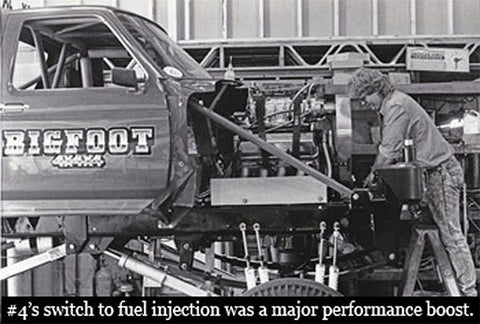
BIGFOOT #4’s first major event with fuel injection would be the TNT Monster Truck Challenge points event at Texas Stadium in Dallas, TX in late April of 1990. By this time, TNT had enacted their ban on the highly-advanced BIGFOOT #8, which according to press reports at the time had won 12 of 15 races up to that point. Thus, with #8 banned, it was up to #4 and Piant to try to preserve the team’s points lead with a machine that, while quite capable, was simply outdated when compared to #8. Piant gave a good accounting of himself, but motor troubles (some of which were related to the new fuel injection system on the truck) kept them from advancing as far into the racing brackets as they would have liked, although the weekend’s event did produce some stellar moments including a tight race between #4 and old nemesis USA-1 that saw the two end trucks nearly get tangled up before USA-1 collided with hay barriers and a portable generator trailer at the end of the arena.
Despite the frustrations the team had to work through in Dallas, they had all but a few minor bugs sorted out on the truck for the following weekend’s event, the kickoff for the ’90 Jamboree season in Rockford, IL. With a strong motor under-hood and a fearless driver behind the wheel, #4 commenced its run at the Special Events 4-Wheel Jamboree Triple Crown championship in high-flying form, much to the delight of the crowds and to the dismay of Piant’s fellow competitors. Piant recalls his time at the Jamborees in #4 with a tinge of nostalgia:
“I loved going to the Jamborees. I was a participant at the Jambos for many years with my show truck. The crowd and the atmosphere were always great. I crewed for Jim [Kramer] at a bunch of them, and when I got behind the wheel of #4 it was really cool to get to actually race at the events I really loved. I went from a spectator in the stands to the guy to beat there. It was awesome to be the first BIGFOOT driver to ever win the Triple Crown championship in 1990; that was definitely one of the bigger feathers in my cap.”
Late in the summer of 1990, Piant took #4 for one of the most spectacular rides of either his or the truck’s career in Nashville, TN during the famed “BIGFOOT Bash”, which featured all but two of the BIGFOOT trucks. Piant, running hard in an effort to keep up with the more advanced trucks in the field (#’s 8 and 9), ended up landing on top of the concrete dividing wall between the lanes of competition, virtually destroying the entire suspension and drivetrain of the truck in what is arguably one of the most destructive non-rollover incidents in the history of the sport. While many fans and critics insist that Piant made what can only be described as a driving error, Piant himself presents an altogether different and compelling version of events to the contrary:
“I have a different version of that story than some guys do. In the video, you can see the front end pull to one side, maybe because of the dust on the track or because of the front locker or some combination of the two. By the time I hit the second jump, I knew it was gonna be bad. By keeping my foot in it, I honestly hoped to clear the center wall and land on the other lane of cars, but that didn’t happen! [Laughs]. At that time Dennis [Anderson] and some of the other guys were starting to wreck pretty spectacularly, but at that time it was definitely one of the worst wrecks ever. At least I’ve made the highlight reel a few times! Physically, for me, it wasn’t that bad at all. About a month prior, I’d had some bad whiplash and I had been struggling to recover and had kept getting hurt, so thankfully that wreck it wasn’t that bad. It was almost like a normal landing! [Laughs] I got out of the truck and the crowd was going nuts and a little later on, sitting in the ambulance as the medics checked me over to make sure I was OK, I saw how much concrete I had rearranged and saw tow truck after tow truck heading back to the pits with wheels and axles and whatnot. We hauled it home on a flatbed that night, so the shop guys could get a start right away on getting it back together. We’re driving home and I thought ‘Wow, this thing is tore up.’ I don’t think Bob [Chandler] was too happy, but the funniest thing about it is, I bet over 100 people must’ve asked if I was gonna be back for the next night’s show!”
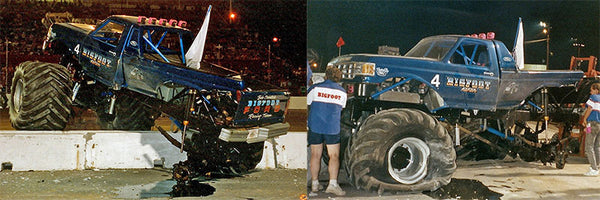
Although BIGFOOT #4 was in a near constant state of evolution and/or improvement around the time of Piant’s Nashville catastrophe, it could be said that in some ways the wreck ensured the prolonged service life of #4, over and above that of BIGFOOTs #6 and #7 (which were theoretically superior trucks to #4.) Repairing #4 at that point was the team’s only option; the tightly booked schedule and lack of time to fabricate another all-new truck from scratch dictated that it must be repaired, not replaced. It was the opinion of many that #4 was virtually totaled after the Nashville wreck, but by some strange twist of fate the wreck ended up guaranteeing that the truck would continue to see use in some sort of improved condition. And with everything the team had been learning from numbers 8 and 9, “improved” in the minds of Bob Chandler and his staff would see #4 return in a condition far from what it had been before the Nashville wreck.
The crew at BIGFOOT immediately set upon repairing #4, specifically the frame and cross members. New wheels, an entirely new suspension, and at least one completely new axle had to be fabricated for the wounded warrior. Rather than adhering to convention, the team eschewed the traditional leaf spring suspension logic and set about creating a “hybrid” suspension that would incorporate more of the nitrogen shock technology found on #8 and #9.
The Phoenix Rises
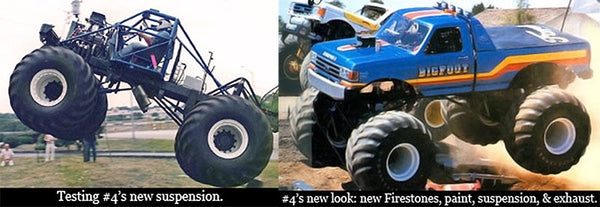
Although #4 had been utilizing one remote reservoir nitrogen shock (as featured on #8 and #9) on each rear corner of the truck for most of the summer of 1990, the team opted to not only re-install them on the rear but to also install them on the front as well. These shocks helped to supplement the long-travel leaf springs that were used in favor of the highly-arched, rigid springs of days past. With all of this new-found suspension travel, a link-bar system of some kind was necessary to keep the suspension in its place during the sure-to-come wild rides the truck would see once it returned to the track. A short-length four-link system was employed to locate both the front and rear axles; these bars were placed so that they allowed the [relatively] supple leaf springs to move through their natural arc during compression. To achieve this, the link barks were set up in a "trailing" fashion, i.e. the link bars connected to the front side of both axles, rather than reaching down to the axles from the center of the truck. With the re-build having taken less than a month and a half, the first competitive test for this new setup would be the 1990 Fall Jamboree Nationals in Indianapolis, where John Piant and co. would attempt to secure the Triple Crown Championship with a virtually all-new truck, a truck very different from the one he had won so many events earlier in the year.
BIGFOOT #4 returned to competition in Indy at the massive State Fairgrounds complex with a fresh new set of clothes to complement its revitalized underpinnings. Joining the ranks of its newer brethren, #4 donned the popular new "racer" paint scheme that featured red and yellow racing stripes laid over a semi-traditional BIGFOOT paint job, a look that up until then only BIGFOOTs #8 and #9 had been using. This event marked Piant's one-year anniversary as the driver of #4, and the came out of the gate with guns blazing, and his twelve months' worth of seat time in the truck showed. For as relatively short of a driving career as Piant had with BIGFOOT when compared to names like Kramer, Brass, Runte and Tack, Piant sure had a knack for generating highlight-reel-worthy footage, and one run of his in particular from Indy was no exception.
Another truck in the field had set the fastest run of the first session of timed competition so Piant, with thoughts of the 1990 championship firmly entrenched in his mind, decided to turn it up to 11 and top the competition. A banzai launch off the first set led to a kamikaze blast off of the final set of cars, which sent Piant and #4 skyward with a brutal landing that subsequently sent the truck into a near-endo. Quick on the throttle, Piant avoided yet another disastrous trip down the track by cutting all 1,100 horses loose from under #4's hood, pulling the truck back down onto all fours. These magnificent few seconds of footage have made countless highlight videos and TV specials, but perhaps most important of all, the run helped secure the 1990 Triple Crown title for Piant and BIGFOOT.
One thing the team quickly learned after #4's "re-debut" at the Indy Jamboree was that the new hybrid suspension, while more supple and less abusive on the driver than the truck's previous setup, was going to be quite the handful in competition, especially when combined with an aggressive driver and a strong power plant. Before long, however, it became apparent that the truck had reached about as competitive of a state as could be achieved with the hybrid setup, so it became up to Piant and succeeding drivers to tame the beast as best as possible.
Piant rounded out the 1990 season with a two-week west coast swing through Portland and Reno, and then on to a trio of SRO/PACE points events in Pittsburgh, St. Louis, and the season-ender in Chicago, IL. The Chicago event, held at the famed Rosemont Horizon (where the oft-used "Chicago-style" form of monster truck racing earned its name), produced some spectacular racing that saw Piant prevail over a tough field of trucks in at least one final round, in addition to finishing in the top-3 behind a technologically superior duo of Taurus and Bear Foot. Piant looks back on his run for a second title in 1990, reflects on his aggressive driving style, and on the evolution of #4:
"At the time the tube truck(s) were pretty new and I kind of knew that [Jim] Kramer and Andy [Brass] were going to be the front-runners in 8 and 9, so I knew that I'd probably be stuck in the old truck [#4] for here on out, so I tried the very best I could to make it competitive. Nobody knew that we were going to end up building a bunch more tube trucks, so I made the most of the shot I had. The truck for whatever reason was always really good to me, and it seemed like every change helped in some way. I think it handled very well for what it was. [In Chicago] I was racing against Taurus and Bearfoot tube trucks, and they were very quick and handled well. And I barely lost the championship to those two at the last race of the year with an "out-dated" truck. I think that says a lot about #4."
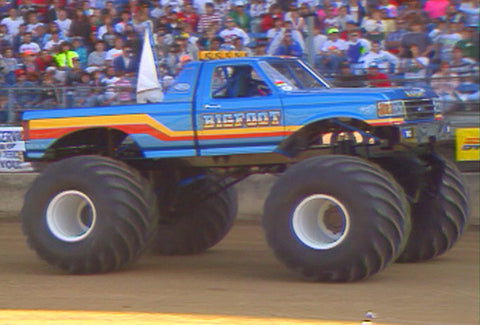 |
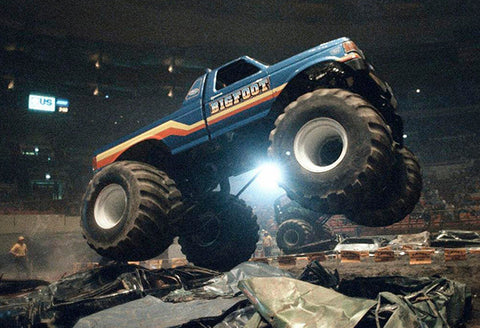 |
Piant's final tour of duty in #4 would encompass the first quarter of the 1991 season, kicking off once again at Madison Square Gardens in NYC, followed by a run of east coast shows and a dome even in Indianapolis, before bidding farewell to #4 and the monster truck world in early March at the Cow Palace in San Francisco, CA. Replacing him for a short stint would be an up-and-coming Dan Runte, followed by permanent replacement and veteran BIGFOOT team member/driver Gene Patterson. Patterson only had but a short time to get acclimated to the truck before both he and #4 took a turn for the "sinister" and assumed the role of Colt Cobra and "Snake Bite", respectively. Shedding factory-looking Ford fiberglass in exchange for a hand-sculpted 3-D fiberglass body that paid homage to the truck's slithery namesake, in April of 1991 BIGFOOT #4 became the first monster truck in history to utilize a 3-D "concept body".
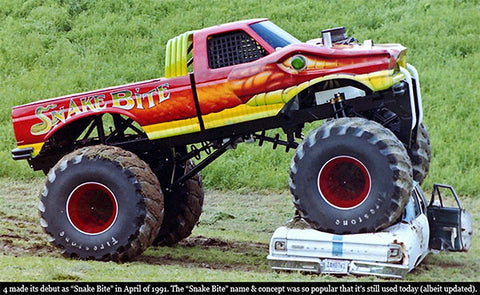
Patterson took the reins of #4 and began the tumultuous task of trying to tame a truck that was expected to compete with machines newer and more advanced than itself, essentially buying time until the team could field more of the modern, tube-chassis trucks. As was the case with Piant before him, Patterson was heavy-footed on the right side and uncompromisingly aggressive behind the wheel.
Naturally, this led to more highlight-reel footage, some of it ranking among the most famous monster truck clips ever. From blown tires to two-wheel escapades to the inadvertent demolition of a track-side storage building in Union Grove, WI, BIGFOOT #4 as Snake Bite was as much of a wild animal as its scaly cousins. Through all of this, #4 underwent very few mechanical changes since its major overhaul in 1990, with the key ingredients to its successes (and rough and tumble failures) being a powerful engine setup, aggressive driver(s), and the somewhat unpredictable hybrid suspension.
When asked about his time in #4 and the challenges it presented, Patterson is at once complimentary, and frank: "BIGFOOT #4 should be nicknamed "the Phoenix" because it just seems to keep rising from the ashes! In an era [1991] of tube chassis and big-travel shocks, we were really pushing the envelope with what could be done with an old truck. Yes, the truck had a few suspension ideas in common with the newer trucks, but really it just morphed year after year, always with something different that helped it to be competitive. After Nashville (1990), we all thought it was done. Little did we know that Bob had other plans! The big thing with the hybrid suspension Bob came up with was that with lockers in those big 5-ton axles and the heavy framework, the truck really had some body roll in the turns and during weird landings. You had to learn how far you could push it, and sometimes you learned the hard way. The truck was still pretty heavy even with the 'glass body and stuff, 12,000 some-odd pounds compared to the 9-and-10,000lb trucks that we were running against back then. But even still, we won our share of races, proving that the old beast could still run. When the PENDA series kicked off, we were still ahead of over half the field with a truck that was the better part of a decade old."
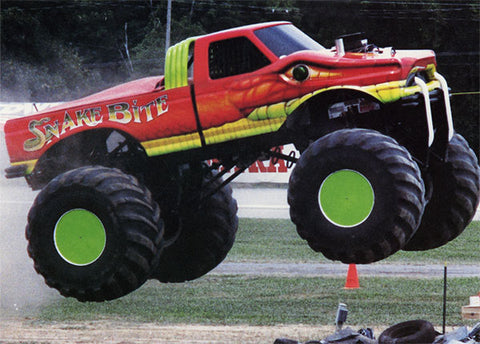
Having spent a great deal of time in a number of other BIGFOOT trucks, some might find it surprising to hear the admiration in Patterson's voice when he recalls driving a truck that probably beat him up more than the rest of the trucks he drove combined, no doubt a result of the truck's wild-at-heart nature. It is clear that he is proud of the truck's accomplishments, even when working against newer equipment.
Snake Bite"A lot of people would laugh and say "Look at that old truck, what're they gonna do with that thing?" But I'll say this, a lot of the guys that pointed and laughed ended up not having the last laugh, because #4 had a way of putting people on the trailer even in its later years. Yes, it was a handful. Yes, you always had to be ready for it to buck you this way or that, or throw you up on the nose because you came up a bit short on a jump. Yes, the interior was cramped. Yes, it rode kind of rough. But its was always an impressive truck. I did some events very late in its racing career and even though some said it should have been retired, it ended up retiring them to their trailer. Truth is, I did some USHRA shows in '97 or '98 with it and the fans never really thought much about the truck or its age, so long as it was BIGFOOT they were fine with it."
With regards to the Snake Bite identity being used on #4 for the first time, Patterson keenly notes a few details that some monster truck historians miss completely.
"How ironic is it that the Snake Bite name should have been kicked off and made famous on a chassis that did so much to help make the BIGFOOT name as famous as it was? I think the unpredictable nature of the truck handling-wise helped define the Snake Bite image as well, the wild rides and all that."
The End of an Era
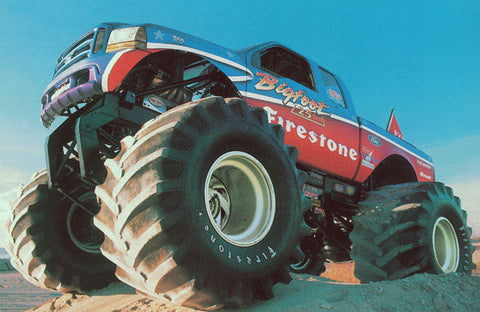
1992 saw the addition of yet another new member to the BIGFOOT fleet, BIGFOOT #10. #10 was the team’s first step in the direction of mid-engine/center-seat tube chassis design. In addition to providing the team with yet another modern race truck in the fleet, it put in clear handwriting on the wall that an old warhorse like #4 should count its days, as they were indeed numbered, at least from a top-level competition point of view. Despite its inability to compete any longer on the larger stages of the monster truck industry, BIGFOOT #4 (running under both the BIGFOOT and Snake Bite names) continued to remain a staple in the team’s fleet of trucks, touring Ford dealerships, fairgrounds races, exhibitions and the like with a high degree of success. Although not officially deemed a training vehicle, #4 invariably served as a tremendously helpful learning platform for future championship-winning BIGFOOT drivers like Eric Meagher, Eric Tack, and Dave Harkey, proving that even in its latter years the truck was still indispensable. According to archived event schedules, the final competition event for #4 under the BIGFOOT name was at The Centrum in Worcester, MA in February of 1998 at a PACE Motorsports event, bringing to an end the on-track career of one of the most resilient, important, and long-lasting monster trucks in history.
From that point forward, BIGFOOT #4 assumed the role of a full-time display truck, occasionally crawling over or parking atop some helpless automobiles when the situation necessitated. Although the truck was no longer in competition, that did not keep it from touring extensively as part of its newfound static display career. By 2006, the truck had accumulated literally hundreds upon hundreds of display appearances, a function critical to any sponsored race team’s livelihood. That same year, having determined the truck no longer necessary to maintain its appearance schedule, the team officially retired BIGFOOT #4 and sold it to a private customer in the state of Missouri and has changed hands a couple times since then. Currently, it is being restored.
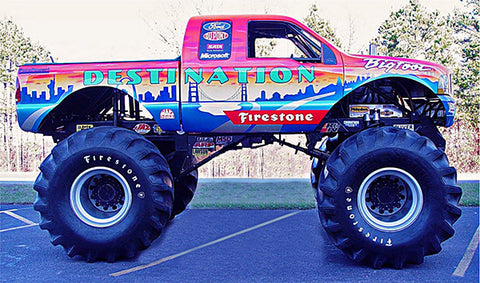
UPDATE (July 2023): BIGFOOT 4, having undergone a complete restoration, re-debuted at the 2023 BIGFOOT Open House. New owner Fred Reep and a team of volunteers from various places restored BIGFOOT 4 to its previous glory, as it appeared after the historic and memorable wreck in 1990.

It would be hard to find an understatement more absurd than saying BIGFOOT #4 was but only a trivial part of the monster truck industry’s history. And while it can truthfully be said that every individual BIGFOOT monster truck owns an important page in the monster truck history books, one would be hard-pressed to pin down another member of the BIGFOOT bloodline (save for BIGFOOT #1 & #8) that has done as much to further the popularity and performance of the monster truck sport and the BIGFOOT team specifically than BIGFOOT #4. If BIGFOOT #1 was the architect that sketched the plans and BIGFOOTs #2 and #3 were the explorers that scouted the way, then BIGFOOT #4 surely provided the callused hands that truly laid the cornerstones and poured the foundations of this sport. Furthermore, it was BIGFOOT #4 that daringly conquered new realms of the monster truck world and showed the industry that a monster truck’s place was in the skies as much as it was on the ground. It showed that quality of workmanship has a timelessness all its own, and that very timelessness is what has made BIGFOOT #4 truly timeless and immortal in the minds of so many.
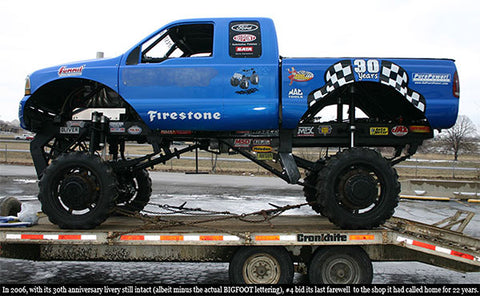

----------------------------------------------------------------------
The Final Word, with BIGFOOT CEO/Founder Bob Chandler
(Interview conducted ca. 2011)
Kyle Doyle: From what you can recall, how early was the concept that would become BIGFOOT #4 being discussed at Midwest back then? Was BIGFOOT #4 already being talked about and/or planned out while #3 was being constructed?
Bob Chandler: I don't recall there being any talks about #4 when we were working on #3. Really, we just started in on the truck when we found the need to build another.
KD: Was it exciting to know that you guys were building a truck that was going to really open up the performance envelope with regards to what a BIGFOOT truck was capable of?
BC: It was exciting every time we built a new truck. We truly thought that every truck we built was going to be better than the last. It was also exciting because we always tried new things with every truck.
KD: Was there a lot of pressure or direction from Detroit (Ford) at the time to make the truck look a certain way, with regards to body lines, fender cut-outs, chrome/no chrome, etc? I ask this because shortly after #4 arrived on the scene, #3's bodywork was altered to more closely match #4's.
BC: Ford mainly just wanted the trucks to look as "factory" as possible. "Product Correct" was their term, if I recall. Probably the reason #3 was changed was because of body damage or something like that. With the drivers getting more aggressive at that time, we found the need to open up the fenders a bit to avoid tire damage.
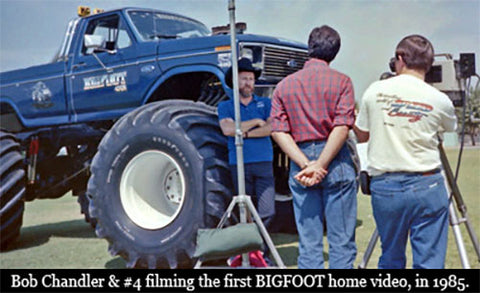
KD: Do you remember the first time you drove the truck over cars or at a show? Does anything stand out in your mind about it?
BC: No [laughs]. Remember, I am a geezer and I don't have to remember anything anymore!
KD: Looking at things from a broader perspective, in what way(s) do you think #4 is an important part to the history of the monster truck industry?
BC: The changes we made to #4 (in comparison to #1-3) in turn made changes to the way other people started building their trucks, which in turn changed the direction of the monster truck industry. The heavier straight-rail frame, the planetary hubs, beefier suspension, etc. #4 helped bring the industry into the Stage 2 era, and really it pointed the way to Stage 3.
KD: What was going through your mind when you surveyed the damage to #4 after it landed on the wall in Nashville? Did you have any idea that the truck was going to be salvageable, much less upgradeable such as it was?
BC: I knew we could fix just about anything, but #4 really was damaged pretty bad, so I questioned whether it would be practical to rebuild it or to just scrap it and build a whole new truck. As you know, we rebuilt it and improved it dramatically and I'm glad we did.
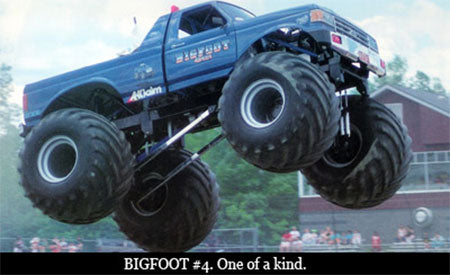
KD: At any point did it surprise you how long #4's career spanned? Were you in any way sad to see it go when it left in 2006?
BC: Yes and no. When you build something, I guess you don't really have any idea how long it is going to last. But we put so much effort into #4 over the years that it never really surprised me that it stayed around so long. I really didn't want to see it sell, but for budgetary reasons we had to let it go. I wish we had it back.
KD: With the International Monster Truck Museum & Hall of Fame beginning to build up steam, do you ever entertain thoughts of re-acquiring #4 and possibly restoring it to its original condition? Along the same lines, with the apparent popularity of the BIGFOOT #1 "clone" project, could you ever see BIGFOOT creating a "replica" of #4, to participate in old-school type events, etc?
BC: Wow, a lot of good questions. As I mentioned before, I would like to have it back and restore it to its working days. It would be great for the old-school events. I truthfully think it would blow the doors off the competition with very little re-working. #4 has done almost everything that more modern Stage 3 trucks have done, but without having gone through a complete stage change.
KD: In a nutshell, if you can, describe what BIGFOOT #4 means to you?
BC: It's a piece of history. It's an inspirational truck. It could do it all. It's a survivor.
Author's Note, by Kyle Doyle
I would personally like to thank everyone involved with the writing of this mechanical biography, starting off of with Bob Chandler and Jim Kramer, the mad scientists at ground zero of the whole BIGFOOT #4 saga. A tip of the helmet as well to former BIGFOOT drivers Rich Hooser, John Piant and Gene Patterson for their valuable input as well. Without them, the personal side of the BIGFOOT #4 story simply would not have been possible to re-create as fully. As a photographer myself, another big thank-you is due to the photographers who over the years helped capture #4 in all of its glory, and in turn helped illustrate this piece.

